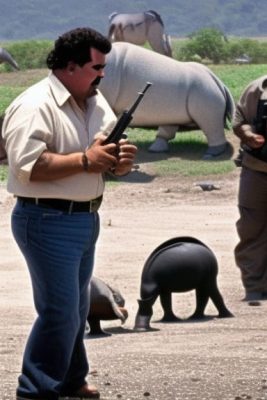Pablo Escobar's Cocaine Hippos
In the late 1980s, notorious Colombian drug lord Pablo Escobar imported four hippos from Africa to live on his estate in Puerto Triunfo. Since then, the hippos have bred and escaped into the wild, creating a unique and controversial ecological situation in Colombia.
Escobar was known for his extravagant lifestyle, and the hippos were just one example of his exotic tastes. He reportedly imported the animals to create his own personal zoo, which also included elephants, giraffes, and other animals.
When Escobar was killed in 1993, the government took control of his estate and transferred the animals to other zoos. However, the hippos were left behind because they were deemed too difficult to transport.
Without human care, the hippos quickly adapted to their new environment and began to reproduce. Now, almost three decades later, there are an estimated 80-100 hippos living in the Magdalena River basin.
The hippos’ escape into the wild has created a unique ecological situation in Colombia. Hippos are not native to the region and have no natural predators, leading to concerns about their impact on local ecosystems. Some scientists have suggested that the hippos may even be filling a missing ecological niche in the region, acting as a substitute for the long-extinct giant llama.
The hippos have also become a popular attraction for tourists, who come to see the “cocaine hippos” of Escobar. The hippos have been featured in documentaries and have even inspired a novel, “The Incredible True Story of the Collarless Hippos of Colombia.”
However, the hippos are not universally loved by the local population. Some residents see them as a nuisance and a danger. Hippos are known for being aggressive, and there have been reports of them attacking humans and damaging property. The Colombian government has even considered culling the hippos to prevent them from further expanding their population.
There are also concerns about the environmental impact of the hippos. Their waste can release dangerous levels of ammonia and nitrogen into the water, leading to algae blooms and oxygen depletion. Some scientists have suggested that the hippos could also spread diseases to native wildlife and even humans.
Despite these concerns, there is no easy solution to the hippo problem. Culling the animals is controversial and could have unintended consequences for the ecosystem. Additionally, the hippos have become a cultural phenomenon in Colombia and have even been embraced as a symbol of the country’s resilience and creativity.
One possible solution is to sterilize the hippos to prevent further reproduction. However, this would be a difficult and expensive process that would require capturing and sedating each animal.
Another option is to relocate the hippos to a more suitable environment, such as a wildlife sanctuary. However, this would also be a difficult and expensive process, and there is no guarantee that the hippos would adapt to their new environment.
For now, the hippos continue to live in the Magdalena River basin, creating a unique and controversial ecological situation. While some see them as a nuisance and a danger, others see them as a symbol of Colombia’s cultural resilience and adaptability. The story of Pablo Escobar’s hippos is a reminder of the complex and often unpredictable ways that humans can impact the environment.


